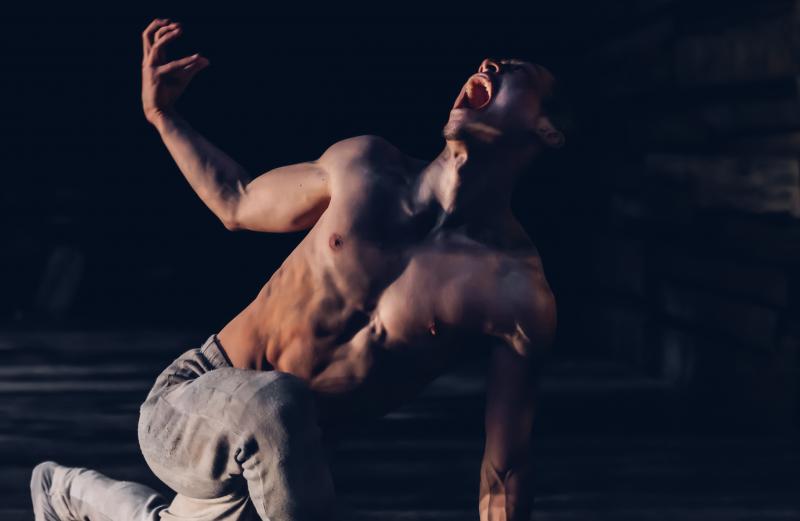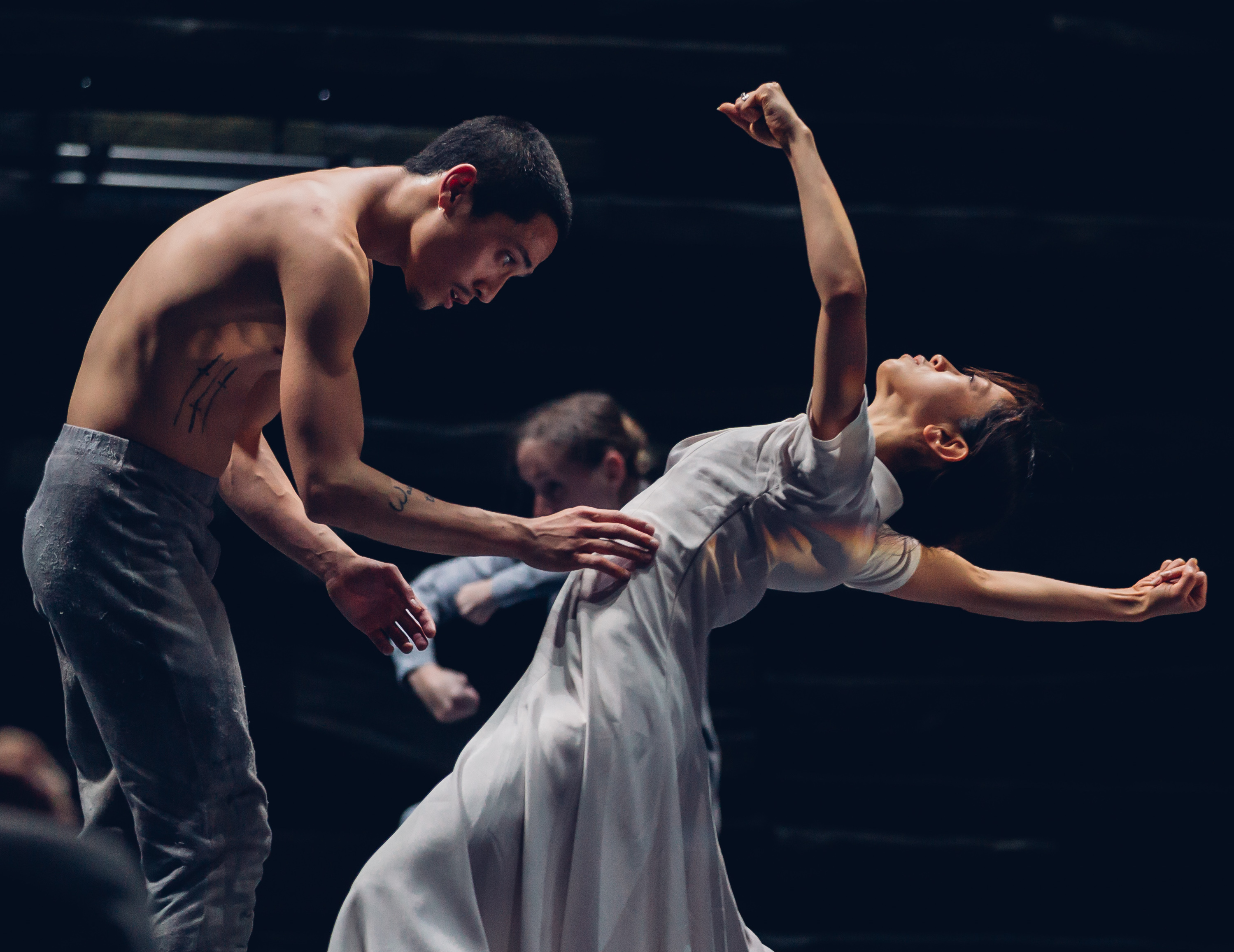Creature review - Asif Kapadia shines light on a dark dance piece | reviews, news & interviews
Creature review - Asif Kapadia shines light on a dark dance piece
Creature review - Asif Kapadia shines light on a dark dance piece
The ballet has been transformed by a film version that gets up close and personal

Filmed ballets involve a different way of watching: you may know a piece well, but you aren’t used to staring into its lead dancers’ eyes as they perform their roles. Not all dancers give good close-up, either. But a new film by the Oscar-winning director Asif Kapadia of Akram Khan’s Creature, made for English National Ballet in 2021, has transformed the original live version into a moving drama.
Creature still isn’t an easy watch. It’s set in a vast murky room with high ceilings and wooden planks for walls. Outside, when the side doors occasionally open, there is blindingly white light and icy mists. The music, by Vincenzo Lamagna (who also worked with Khan on his excellent reworking of Giselle for ENB), is all pulsing drones, foghorns, and electronic bleeps, with occasional excursions into melody (and a spectral chunk of Ravel’s Bolero).
In this space, a man is being kept captive. The film version first shows us the Arctic wastes outside his cell, where a young fox is picking its way through the ice. The next shot is of what looks like more of this snowy terrain, a humped hill with dark patches that look like small craters. But this isn’t a moonscape: suddenly, fingers appear and we realise we are watching the Creature’s hunched back, which he is clutching with crossed arms in some kind of pain.
Immediately, Kapadia has turned the piece from a busy spectacle to be watched from one angle only – the front – into an absorbing in-the-round drama. He is aided in this by the supreme acting talent of his Creature, Jeffrey Cirio, a mercurial American dancer whose bravura skills enhanced ENB’s productions for several years before his recent return to Boston Ballet. Who knew he could do screen acting this well? From the best seats in the house you still wouldn’t see the subtlety of his facial expressions with this much clarity.
Cirio is matched by the luminous Erina Takahashi as Marie (pictured below with Cirio), the lab cleaner he becomes obsessed with and approaches with childlike wonder, her soulful face as expressive as her flowing dance moves. In their first duet, he dances with her apparently sleeping body in a ghostly image of a lovers’ duet.
Those who know Büchner’s Woyzeck will by now have realised that this Creature is only tangentially related to Dr Frankenstein’s. He has that character’s unworldly naivety but, like Büchner’s anti-hero, is not a lab experiment but a wretch reduced to becoming one –he’s undergoing trials here to see how well he can withstand isolation and sub-zero temperatures. Far away, the US has just put a man on the moon, and President Nixon’s congratulatory address to the astronauts plays over unseen speakers, popping up in snippets throughout the piece. For Marie and the Creature, the heavens – and the rocket we glimpse in quick cuts powering upwards, which they frequently point to in awe – are a source of fascination, representing escape from the earthly constraints they labour under.
Any respite the two have, though, is regularly interrupted by the workers and guards at this research facility, let by a fierce Doctor (Stina Quagebeur), a kind-hearted Captain (Ken Saruhashi) and a violent Major (Fabian Reimair), who march in with their troops in slow motion, progressing in exaggerated goose-steps, their heads clunking back robotically. Throughout, this strong corps are impressive.
The pathos of the piece comes in the Creature’s tragic desire to be like them: he mimics their movements, play-acts to Nixon’s speech, copies a man scrubbing a floor and shadows his moves. He learns to dance in unison with the others, a minor triumph for him, and wipes his hands, comically, like the Major. Cirio is in his element, leaping and slithering and writhing until unseen forces (electric shocks?) make his body convulse, then becoming tender and sweet-natured.
 Kapadia doesn’t overplay his cinematic tricks. He can give the Creature quick flashbacks, and jump-cuts with visual static whenever he puts on a space helmet and his body starts to judder; more importantly, Kapadia and his editor (Sylvie Landra) know how to vary the scale of what we see, from panoramic whirling ensembles to close-ups. I confess I watched the piece at its stage premiere in a state of confusion, verging on boredom. Its claustrophobic gloominess was so unrelieved, its intentions too obscure and its fine dance elements not enough to lift the gloom, which was enforced further by Lamagna’s near-inhuman music.
Kapadia doesn’t overplay his cinematic tricks. He can give the Creature quick flashbacks, and jump-cuts with visual static whenever he puts on a space helmet and his body starts to judder; more importantly, Kapadia and his editor (Sylvie Landra) know how to vary the scale of what we see, from panoramic whirling ensembles to close-ups. I confess I watched the piece at its stage premiere in a state of confusion, verging on boredom. Its claustrophobic gloominess was so unrelieved, its intentions too obscure and its fine dance elements not enough to lift the gloom, which was enforced further by Lamagna’s near-inhuman music.
Kapadia, though, unlike somebody in a theatre audience, has worked out exactly which part of the stage action to focus his camera on and when, so that the storyline becomes clear. It’s still a mirthless tale in a cruel universe (as is Woyzeck, after all), with just the tenderness of the Creature, the kindness of the Captain, and the sad dignity of Marie to cling to. But Kapadia has given it a human face and it now has real dramatic punch.
rating
Share this article
The future of Arts Journalism
You can stop theartsdesk.com closing!
We urgently need financing to survive. Our fundraising drive has thus far raised £49,000 but we need to reach £100,000 or we will be forced to close. Please contribute here: https://gofund.me/c3f6033d
And if you can forward this information to anyone who might assist, we’d be grateful.

Subscribe to theartsdesk.com
Thank you for continuing to read our work on theartsdesk.com. For unlimited access to every article in its entirety, including our archive of more than 15,000 pieces, we're asking for £5 per month or £40 per year. We feel it's a very good deal, and hope you do too.
To take a subscription now simply click here.
And if you're looking for that extra gift for a friend or family member, why not treat them to a theartsdesk.com gift subscription?

Add comment